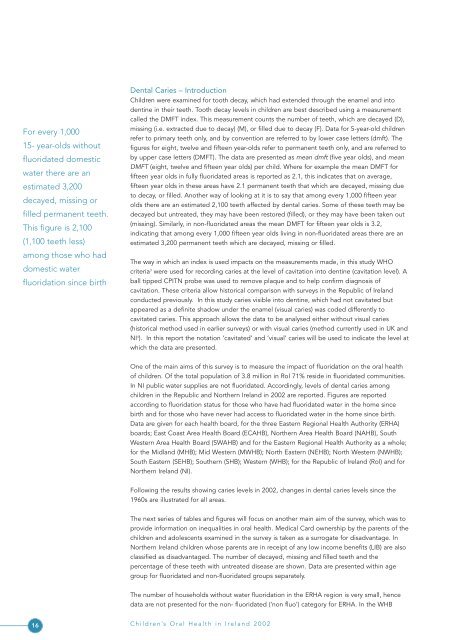Oral Health inside - Communities and Local Government
Oral Health inside - Communities and Local Government
Oral Health inside - Communities and Local Government
You also want an ePaper? Increase the reach of your titles
YUMPU automatically turns print PDFs into web optimized ePapers that Google loves.
For every 1,00015- year-olds withoutfluoridated domesticwater there are anestimated 3,200decayed, missing orfilled permanent teeth.This figure is 2,100(1,100 teeth less)among those who haddomestic waterfluoridation since birthDental Caries – IntroductionChildren were examined for tooth decay, which had extended through the enamel <strong>and</strong> intodentine in their teeth. Tooth decay levels in children are best described using a measurementcalled the DMFT index. This measurement counts the number of teeth, which are decayed (D),missing (i.e. extracted due to decay) (M), or filled due to decay (F). Data for 5-year-old childrenrefer to primary teeth only, <strong>and</strong> by convention are referred to by lower case letters (dmft). Thefigures for eight, twelve <strong>and</strong> fifteen year-olds refer to permanent teeth only, <strong>and</strong> are referred toby upper case letters (DMFT). The data are presented as mean dmft (five year olds), <strong>and</strong> meanDMFT (eight, twelve <strong>and</strong> fifteen year olds) per child. Where for example the mean DMFT forfifteen year olds in fully fluoridated areas is reported as 2.1, this indicates that on average,fifteen year olds in these areas have 2.1 permanent teeth that which are decayed, missing dueto decay, or filled. Another way of looking at it is to say that among every 1,000 fifteen yearolds there are an estimated 2,100 teeth affected by dental caries. Some of these teeth may bedecayed but untreated, they may have been restored (filled), or they may have been taken out(missing). Similarly, in non-fluoridated areas the mean DMFT for fifteen year olds is 3.2,indicating that among every 1,000 fifteen year olds living in non-fluoridated areas there are anestimated 3,200 permanent teeth which are decayed, missing or filled.The way in which an index is used impacts on the measurements made, in this study WHOcriteria 3 were used for recording caries at the level of cavitation into dentine (cavitation level). Aball tipped CPITN probe was used to remove plaque <strong>and</strong> to help confirm diagnosis ofcavitation. These criteria allow historical comparison with surveys in the Republic of Irel<strong>and</strong>conducted previously. In this study caries visible into dentine, which had not cavitated butappeared as a definite shadow under the enamel (visual caries) was coded differently tocavitated caries. This approach allows the data to be analysed either without visual caries(historical method used in earlier surveys) or with visual caries (method currently used in UK <strong>and</strong>NI 4 ). In this report the notation ‘cavitated’ <strong>and</strong> ‘visual’ caries will be used to indicate the level atwhich the data are presented.One of the main aims of this survey is to measure the impact of fluoridation on the oral healthof children. Of the total population of 3.8 million in RoI 71% reside in fluoridated communities.In NI public water supplies are not fluoridated. Accordingly, levels of dental caries amongchildren in the Republic <strong>and</strong> Northern Irel<strong>and</strong> in 2002 are reported. Figures are reportedaccording to fluoridation status for those who have had fluoridated water in the home sincebirth <strong>and</strong> for those who have never had access to fluoridated water in the home since birth.Data are given for each health board, for the three Eastern Regional <strong>Health</strong> Authority (ERHA)boards; East Coast Area <strong>Health</strong> Board (ECAHB), Northern Area <strong>Health</strong> Board (NAHB), SouthWestern Area <strong>Health</strong> Board (SWAHB) <strong>and</strong> for the Eastern Regional <strong>Health</strong> Authority as a whole;for the Midl<strong>and</strong> (MHB); Mid Western (MWHB); North Eastern (NEHB); North Western (NWHB);South Eastern (SEHB); Southern (SHB); Western (WHB); for the Republic of Irel<strong>and</strong> (RoI) <strong>and</strong> forNorthern Irel<strong>and</strong> (NI).Following the results showing caries levels in 2002, changes in dental caries levels since the1960s are illustrated for all areas.The next series of tables <strong>and</strong> figures will focus on another main aim of the survey, which was toprovide information on inequalities in oral health. Medical Card ownership by the parents of thechildren <strong>and</strong> adolescents examined in the survey is taken as a surrogate for disadvantage. InNorthern Irel<strong>and</strong> children whose parents are in receipt of any low income benefits (LIB) are alsoclassified as disadvantaged. The number of decayed, missing <strong>and</strong> filled teeth <strong>and</strong> thepercentage of these teeth with untreated disease are shown. Data are presented within agegroup for fluoridated <strong>and</strong> non-fluoridated groups separately.The number of households without water fluoridation in the ERHA region is very small, hencedata are not presented for the non- fluoridated (‘non fluo’) category for ERHA. In the WHB16 Children’s <strong>Oral</strong> <strong>Health</strong> in Irel<strong>and</strong> 2002
















